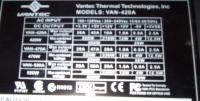4-Way Power Supply Shootout: Vantec, Enermax, ThermalTake, Antec
by Kristopher Kubicki on January 17, 2003 4:31 AM EST- Posted in
- Cases/Cooling/PSUs
Math, Anyone?
One of the more interesting things we discovered when doing this review were the inconsistencies in the mathematics in each of the power supplies. Below you will see the advertised breakdown of each power supply’s current and max wattage; italic values denote values we calculated ourselves.
Antec Truepower (Advertised as 430W)
|
|
+3.3V |
+5V |
+12V |
-12V |
-5V |
+5VSB |
|
Max Output Current |
28.0A |
36A |
20A |
1.0A |
0.5 |
2.0 |
|
Max Combined Wattage |
410W |
12W |
2.5W |
10W |
||
Vantec Stealth (Advertised as 420W)
|
+3.3V |
+5V |
+12V |
-12V |
-5V |
+5VSB |
|
|
Max Output Current |
26A |
42A |
18A |
1.0A |
0.8A |
2.5A |
|
Max Combined Wattage |
200W** |
216W |
12W |
4W |
12.5W |
|
ThermalTake Purepower (Advertised as 420W)
|
+3.3V |
+5V |
+12V |
-12V |
-5V |
+5VSB |
|
|
Max Output Current |
30A |
40A |
18A |
0.8A |
0.3A |
2.0A |
|
Max Combined Wattage |
220W |
216W |
9.6W |
1.5W |
20.0W |
|
Enermax EG465 (Advertised as 460W)
|
+3.3V |
+5V |
+12V |
-12V |
-5V |
+5VSB |
|
|
Max Output Current |
35A |
35A |
33A |
1.0A |
1.0A |
2.2A |
|
Max Combined Wattage |
200W |
396W? |
12W |
5W |
11W |
|
Many of us know, power can easily be computed from as current times voltage (P = IV). The problem appears to be that these figures seem to add up inconsistently. Antec advertises their 3.3V, 5V and 12V rail each have their own dedicated circuitry. Unfortunately, the maximum out put cannot be roughly obtained by calculating the wattages for the 3 main rails and then adding them together. Even though it is not fully disclosed, the three main rails are usually limited with another total wattage rating. In Antec’s case, this total wattage is 410W.
As we discussed earlier, the 3.3V and 5V rails are both shared on the same transistor (except on the Antec Truepower). This means, the combined wattage on the +3.3V and +5V rail are taken in account together. When looking at Vantec’s Stealth, the label claims to put out 42A on the +5V rail alone. The maximum combined wattage for both rails is advertised at 200W. Using P = IV, the total power output on the +5V rail should be 210W. We were slightly puzzled as to how the maximum wattage on both rails is less than the maximum wattage of just the 5V rail.

Vantec Stealth 420W Side Label
**After contacting Vantec about this irregularity, we were pleased to hear the 200W combined wattage on the label of the unit was a misprint. Vantec let us know the combined wattage on the +3.3V and +5V rails is actually 220W. However, they also informed us that the combined wattage on all three primary rails (+3.3V, +5V and +12V) is only 400W, less then the combined wattage of the Antec unit.










6 Comments
View All Comments
Sir Fredrick - Tuesday, January 11, 2005 - link
I would have really liked to see them compare the current draw from the wall, to see how the PSUs compare in terms of energy efficiency.Anonymous User - Friday, August 22, 2003 - link
Switching power supply means the unit can be switched between American 60 Hz, 120 v, and European 50 Hz, 240 v input.Jeff7 - Monday, June 18, 2012 - link
"Switching power supply" refers to precisely what the article says. The "switch" refers to the manner in which the incoming power is handled, not to a physical component on the unit.Plenty of switching power supplies, also called SMPS (switch-mode power supplies), are available without any switches.
Beside me is a switcher supply that accepts 100-240VAC and puts out 12VDC. There are no switches on it.
Some of the circuitry I work with uses small switcher supplies, which take 12-36VDC and put out a solid 12VDC output.
I also work with boosters, which are a kind of switching power supply topology that's capable of putting out a higher voltage than what comes in. These particular ones can take 12VDC and put out about 17.5VDC.
And, I'm looking at a power supply for integration into a new product, and it can handle anything from 85-264VAC at 47-440Hz. Again, no switches on it.
Some of the older or cheaper switcher supplies *do* indeed have the selector switch on them to let them accommodate different voltages. But that's not what makes them "switching" power supplies. The name "switch" being the same is simply a coincidence.
Anonymous User - Friday, August 8, 2003 - link
:):):):):):):):)Anonymous User - Thursday, August 7, 2003 - link
Anonymous User - Thursday, August 7, 2003 - link
PFC, power factor correction, is not just about noise. The square wave shape of current draw of non PFC corrected supplies adds a significant 3rd order harmonics element to the line. This usally is gets diverted by the impedance of power company transformers to flowing in the Neutral line of the power system, which in the past carried almost no current. This nuetral line was installed at a SMALLER size than the mains. There have been buildings burned up in Europe, (which has an older infrastructure) because of this. Also, drawing higher peaks instead of sinusoidal current is less efficient and adds more loss the the wires and transformers, shortening their life and adding more pollution to the world, (ie. more power has to be generated to make up the loss, resulting in more smokestack emissions).